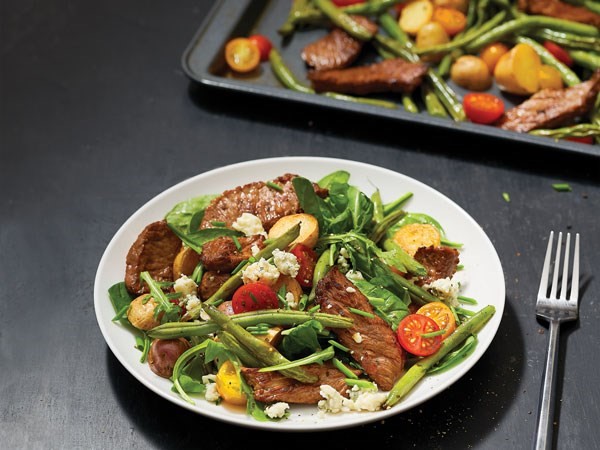
By: April Graff, MS, RD, LD. Hy-Vee Dietitian
As your training schedule picks up, finding quick meals that can be made (and cleaned up) in a hurry are a necessity. This is where sheet pan meals come in.
A sheet pan takes the concept of a one-pot meal and flips it onto a pan. It saves time, makes clean-up easier, and doesn’t require expensive equipment or fancy ingredients. Just start with your protein of choice, then add vegetables, fat and flavorings, and roast at high heat until everything is golden brown.
Here’s how.
Choose a Protein
Whether you decide on poultry, beef, pork, fish or tofu, you’ll want to start with ¼ to ¾ pound per serving, to be supplemented with vegetables.
Add Vegetables
Protein in hand, it’s time to pick the vegetables that’ll round out your meal. How many, and how much, are up to you. But remember that vegetables cook down significantly under high temperatures, so always err on the side of more. When working with vegetables, make sure they’re cut consistently.
- Dense vegetables — potatoes, radishes, winter squashes — take the longest to cook, (around 30 minutes for bite-sized pieces).
- Vegetables with a higher moisture content (mushrooms, tomatoes, onions) can take less time, 10 to 20 minutes.
- Leafy vegetables — kale, bok choy, chard — will cook fastest, 3 to 10 minutes. If the leaves are thoroughly dry, they will turn crisp and brown.
Building Flavor
Once you’ve chosen your main ingredients it’s time to get creative with the seasonings. Fat, herbs, spices and garnishes all add to the character of the finished dish.
Fat encourages browning and helps evenly cook the ingredients on your sheet pan. Olive oil is the classic choice, but feel free to get creative with coconut oil, peanut oil, or avocado oil. Simply toss ingredients with enough fat so they are lightly coated.
Sprigs of sturdy, branchy fresh herbs can stand up to lengthy cooking without burning. Thyme, lemon thyme, oregano, marjoram, rosemary, bay leaves, tarragon and sage are all good choices; just throw them on the pan with the other ingredients. Dried herbs are excellent added to a marinade, paste or rub. Save soft, fresh herbs like basil, chives, parsley, cilantro and mint as a garnish after cooking.
Add a Bright Finish
Consider adding fresh, soft herbs, squeezes of citrus or drizzles of vinegar, yogurt, vinaigrettes, grated or crumbled cheeses, salsas, and hot sauces.
If you still find yourself seeking inspiration, here are 12 meals that began with just the basics, and evolved into something impressive in a few simple steps.
Link: 12 Family-Friendly Sheet Pan Dinners That Keep Your Sink Clean | Hy-Vee




